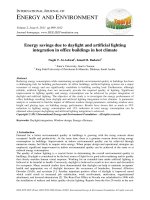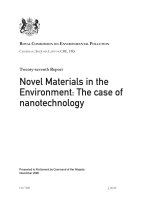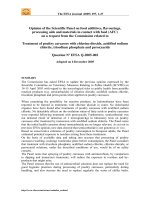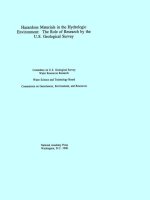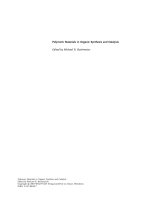materials in hot climates
Bạn đang xem bản rút gọn của tài liệu. Xem và tải ngay bản đầy đủ của tài liệu tại đây (49.72 KB, 5 trang )
Building materials in the hot climate zones
Cane and leaves are available in the warm-humid zones and
grass in the intermediate and subtropical zones. Vine, bamboo
and palm-fronds are used for buildings in the warm-humid
zones. Because these materials are light, do not store heat,
and allow the free passage of air, they are frequently used for
making roofs. However, they have a relatively short life span
because they deteriorate rapidly due to termite attack. They
are also highly combustible.
Both hardwoods and softwoods are found in most tropical and
subtropical areas with the exception of the hot dry zones. On
external woodwork preservative stains should be used rather
than paints, which tend to deteriorate fairly rapidly in the hot
zones. Extremes of climatic conditions cause dimensional
changes producing cracks, splits and warping. Wind-blown
sand and grit gradually erode exposed timber. In warm-humid
zones timber is liable to wet and dry rot and to attack by
termites and beetles.
• Earth is one of the most widely used traditional building materials in
hot-dry lands. Earth is used not only for walls but also for roofs; mud
brick vaults and domes are common in countries like Iran and Egypt.
Because mud has less strength than most other construction
materials, mud walls are built thicker. Partly due to the thickness of
mud walls and partly due to its slow thermal conductivity, rooms built
of mud are much cooler in hot climates than those of any other
materials. Mud bricks are brittle and do not withstand tension well.
For this reason the vault and the dome were evolved in the East.
There is a high risk of termite damage in some areas. Walls exposed
to weathering and rain require frequent repair work.
Concrete and reinforced concrete are widely used throughout the non-temperate
zones. Cement is manufactured locally in many places. Sand is found almost
everywhere, but it may be contaminated with soluble salts. Suitable aggregate may be
difficult to find. Concrete is most frequently used for the structure, foundations and
floor slabs of buildings. Care must be taken when using concrete for walls and roofs.
Heat builds up on the exterior of concrete walls and roofs due to solar radiation and
surface temperature usually exceed air temperature. Then, because concrete walls
tend to be thin and concrete has low resistance to the passage of heat, heat is
conducted into the interior. Salts in aggregate and water can cause corrosion of the
reinforcement and subsequent spalling of the concrete cover. In hot-dry areas the
rapid evaporation and shortage of water can result in low strength, cracking and high
permeability.
MATERIAL
AVAILABILITY
USE
PROPERTIES
PROBLEMS/ DURABILITY
cane, leaves, vine, bamboo, Warm-humid zones
palm-fronds
Grass
Hardwoodsand softwoods
Earth
Concrete
